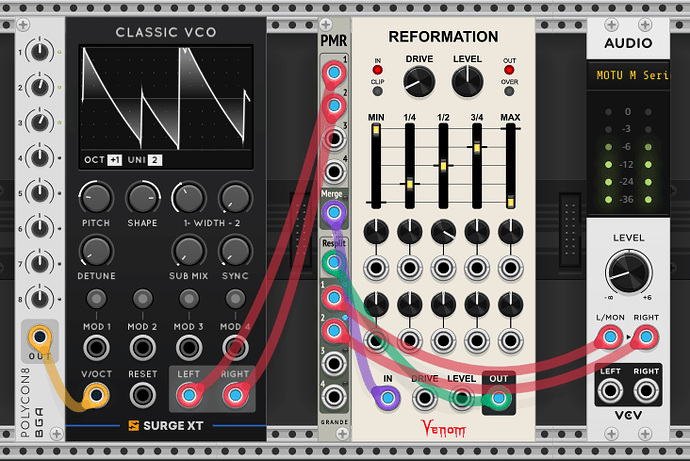Here is a summary of the changes, with more details about the new modules below.
2.3.0 (2023-07-03)
New Modules
- Poly Unison
- Reformation
- Shaped VCA
Behavior Change
- Bernoulli Switch: The B input now remains normalled to the A input when bypassed, which in turn can affect the bypassed B output.
Bug Fixes
- HQ
- The selected channel for monitoring is now saved with the patch
- Recurse Stereo
- Fixed Right Signal output label
- VCA Mix 4
- Excluded patched channel outputs no longer contribute to the polyphony count in the Mix output
- VCA Mix 4 Stereo
- Excluded patched channel outputs no longer contribute to the polyphony count in the Mix output
- Fixed Right Mix output label
Poly Unison
![]()
This module is pretty straight forward. There were already a few modules available to convert a monophonic V/Oct signal into polyphonic unison with a detune spread. But that does not work well if your incoming V/Oct signal is already polyphonic. I ran into this as I was developing my Roland JX8P emulation patch, from which sprung the idea for this module. It functions nearly the same as my Poly Clone, replicating each incoming channel N times, and packaging it all up in one polyphonic output. But Poly Unison also provides a detune spread for each of the incoming V/Oct values.
It works great for thickening up each voice in a polyphonic oscillator, with a detune spread up to 1 semitone. But there are other range options that make it convenient to generate harmonic intervals as well.
It also can be used for CV other than V/Oct, such as to clone polyphonic velocity and after touch to be used in parallel with the detuned unison. You will need the channel counts to match between your velocity, after touch, and detuned unison. You don’t need the detune for velocity or after touch, so Poly Clone could work as well, except it does not have the CV control over the clone count.
You can see how Poly Unison greatly simplified the third version of my JX8P emulator.
Reformation

This polyphonic CV controlled voltage mapper and waveshaper is heavily inspired by the Klavis Flexshaper Eurorack module. I opted to use sliders instead of knobs because I think it gives a much better visual representation of the mapping being applied. The input and output can be independently configured for unipolar or bipolar, and it works great with both CV and audio.
The real fun begins with two CV inputs and attenuverters for each of the mapping way points. I like to use one CV input for a LFO to introduce slowly changing harmonics, and the other for audio rate amplitude modulation of a portion of the input wave. With 5 mapping way points, you can have 5 overlapping regions of audio rate amplitude modulation, each with its own modulation frequency.
It also gives options for hard or soft saturation clipping, with independent CV control over both drive and output level. So you can dynamically saturate the output, and/or use Reformation as a VCA.
Finally it has optional oversampling to control aliasing when shaping high frequency content.
Shaped VCA
![]()
This stereo polyphonic VCA offers CV control over the response curve, going from exponential to linear to logarithmic. This was another module that sprang from my work on the JX8P emulation. I was surprised to only find the Befaco Hex Mix module with this capability, except the Hex Mix did not handle polyphony the way I needed.
Other features include
- Level range options to support attenuation and/or amplification and/or inversion
- bipolar VCA mode to support ring modulation
- hard and soft saturation clipping options
- oversampling options to control aliasing
- A level input bias control that can be used to dial in some ratio of amplitude modulation and ring modulation when using the bipolar VCA mode.
The left input is normalized to 10V, so it is convenient to use Shaped VCA as a wave shaper. Simply patch your audio signal to the Level input, leaving the IN input unpatched, bias the Level input by 5 volts to make it unipolar, and shape the wave with the response curve and clipping options. You might want to use the bipolar VCA mode for this just in case your input exceeds 10V peak to peak. You can use the output offset option to restore the output to bipolar. You probably will need both clipping and oversampling if wave shaping with any amount of a logarithmic response curve.
If you try ring modulation using the logarithmic curve, you definitely will want both clipping and oversampling!
The left and right channels need not be used for stereo applications. You can pass an envelope or ring modulator signal into the Level input, and modify the signal with the response curve. You can patch your audio into the right IN, leaving the left IN unpatched. The Left OUT will have your modulated level input, and the right will have your amplified or attenuated or ring modulated output.
